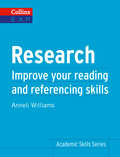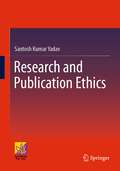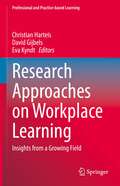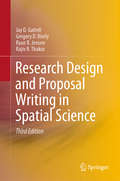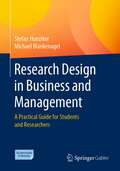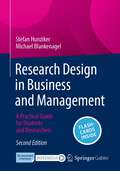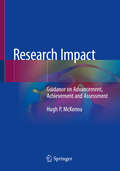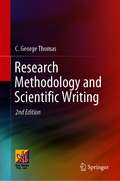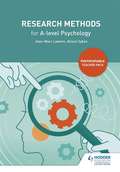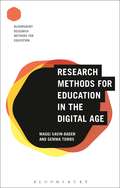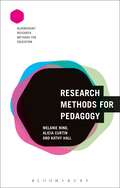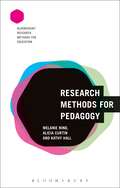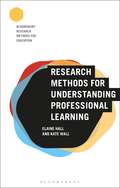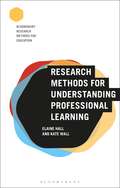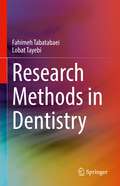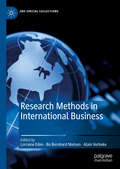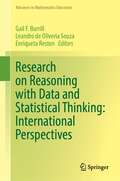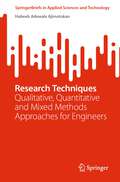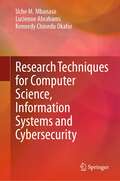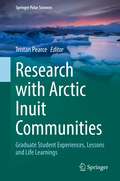- Table View
- List View
Religious Studies Skills Book: Close Reading, Critical Thinking, and Comparison
by Eugene V. Gallagher Joanne MaguireStudying religion in college or university? This book shows you how to perform well on your course tests and examinations, write successful papers, and participate meaningfully in class discussions. You'll learn new skills and also enhance existing ones, which you can put into practice with in-text exercises and assignments. Written by two award-winning instructors, this book identifies the close reading of texts, material culture, and religious actions as the fundamental skill for the study of religion at undergraduate level. It shows how critical analytical thinking about religious actions and ideas is founded on careful, patient, yet creative “reading” of religious stories, rituals, objects, and spaces. The book leads you through the description, analysis, and interpretation of examples from multiple historical periods, cultures, and religious traditions, including primary source material such as Matthew 6:9-13 (the Lord's Prayer), the gohonzon scroll of the Japanese new religion Soka Gakkai, and the pilgrimage to Mecca (hajj). It provides you with typical assignments you will encounter in your studies, showing you how you might approach tasks such as reflective, interpretive or summary essays. Further resources, found on the book's website, include bibliographies, and links to useful podcasts.
The Renal System E-Book: Systems of the Body Series (Systems of the Body)
by Michael J. Field Carol Pollock David HarrisThis is an integrated textbook on the renal system, covering the anatomy, physiology and biochemistry of the system, all presented in a clinically relevant context appropriate for the first two years of the medical student course.One of the seven volumes in the Systems of the Body series.Concise text covers the core anatomy, physiology and biochemistry in an integrated manner as required by system- and problem-based medical courses.The basic science is presented in the clinical context in a way appropriate for the early part of the medical course.There is a linked website providing self-assessment material ideal for examination preparation.
Report Writing (Pocket Study Skills)
by Michelle ReidPractical and concise, this is a student’s essential guide to writing effective reports. It shows students how to tailor report structures and conventions to different audiences and purposes and how to manage changes in format and requirements, so that they have the tools to write reports with confidence. Real-life examples from a wide range of student reports demonstrate features of good report writing, and a comprehensive checklist keeps students on track. This is an invaluable resource for all students who are required to write reports as part of their degree course.
Report Writing (Pocket Study Skills)
by Michelle ReidPractical and concise, this is the essential guide to writing effective reports. It shows students how to tailor report structures and conventions to different audiences and purposes and how to manage changes in format and requirements, so that they have the tools and understanding to write reports with confidence. It includes real-life examples of student reports to illustrate the features of good report writing, and a comprehensive checklist to keep students on track.This is an invaluable resource for students of all levels who are required to write reports as part of their course.New to this Edition:- Contains a new section on demonstrating critical analysis in the key parts of a report, including the literature review, methodology and findings- Additional guidance on effective writing style
Research: B2+ (Collins Academic Skills)
by Anneli WilliamsImprove your reading and referencing skills
Research and Publication Ethics
by Santosh Kumar YadavThis textbook aims to provide awareness about research ethics, misconduct and the ensuing actions as per international law, information on open access publishing and predatory publishing. Many fresh research scholars are not fully acquainted with the rules governing copyright infringements, plagiarism and intellectual property rights. As such the book presents its various features in a lucid style, and the latest updates on the use of information technology in retrieving and managing information through various means in an ethical manner. The book is useful for students, young researchers and professionals.
Research Approaches on Workplace Learning: Insights from a Growing Field (Professional and Practice-based Learning #31)
by Christian Harteis Eva Kyndt David GijbelsThe volume comprises a variety of research approaches that seek to explore and understand employees’ learning and development through and for work. Working life reveals challenges through technological, economic and societal development that can only rudimentarily be addressed by formal education and training. Workplace learning becomes more and more important for employees and enterprises to successfully cope with these challenges.Workplace learning is a steadily growing field of educational research but it lacks so far a scholastic canon – there is rather a diversity of research approaches. This volume reflects this diversity by bringing together researchers from different countries and different theoretical backgrounds, presenting their current research on topics that all are relevant for understanding presages, processes and outcomes of workplace learning. Hence, this volume is of relevance for researchers as well as practitioners in the field and policy makers.
Research Design and Proposal Writing in Spatial Science: Second Edition
by Jay D. Gatrell Gregory D. Bierly Ryan R. Jensen Rajiv R. ThakurThe investigation of the interactions between human and physical systems poses unique conceptual, methodological, and practical challenges. This book establishes a spatial science framework for policymakers, social scientists, and environmental researchers as they explore and analyze complex problems. The authors provide guidance for scientists, writers, and students across a broad range of fields on how to tackle discipline-specific issues of space, place, and scale as they propose and conduct research in the spatial sciences. This practical textbook and overview blends plenty of concrete examples of spatial research and case studies to familiarize readers with the research process, demystifying and illustrating how it is actually done. The appendix contains both completed and in-progress proposals for MA and PhD theses and dissertations, as well as successful research grants. By emphasizing research as a learning and experiential process, while providing students with the encouragement and skills needed for success in proposal writing, "Research Design and Proposal Writing in Spatial Science" can serve as a textbook for research-design or project-based courses at the upper-division undergraduate and graduate level.
Research Design in Business and Management: A Practical Guide for Students and Researchers
by Stefan Hunziker Michael BlankenagelThe present book project on Research Design, which is planned in English, is intended to create an innovative textbook that can be used at university undergraduate and graduate levels in internationally oriented education in the German-speaking countries. This textbook shall provide comprehensive guidance for students when tackling their (applied) research papers. Instead of reiterating qualitative and quantitative methods it focuses on how to come up with an appropriate research design that allows the student to make the intended intellectual contribution. Starting from the desired (hypothetical) conclusion or statement the student will be guided through the process of finding the appropriate Research Question that will be answered by such a statement and the required Research Design consisting of data collection and data analysis, that allows for such a statement as the conclusion of the study. Common Research Designs in Business and Management, i.e. well beyond the standard Research Designs of Social Sciences and curtailed to the focus area, will be described with regard to their suitability to answer specific kinds of questions as well as the idiosyncrasies of the these Designs and their impact on the written research reports. Examples for each Research Design will be provided as well as guidance about how to write about such research.
Research Design in Business and Management: A Practical Guide for Students and Researchers
by Stefan Hunziker Michael BlankenagelThis textbook on research designs provides undergraduate and graduate students with detailed guidance to tackle their research projects. It has been recommended and developed for university courses in Germany, Austria, and Switzerland. The authors offer students relevant research designs in business and management. They show how to overcome the common qualitative and quantitative methods divide. For this purpose, the textbook focuses on the scientific problem-solving process. It emphasizes the importance of an appropriate research design to produce intellectual contributions. The authors describe the most relevant research designs in business and management research. They assess each research design about its suitability to answer specific research questions. The textbook also covers academic writing and provides valuable tips about the whole research process. It not only serves students as a resource to conduct their research projects. Moreover, it is also a helpful reference throughout the entire academic career.
Research Impact: Guidance on Advancement, Achievement and Assessment
by Hugh P. McKennaResearch for research sake is no longer tenable or affordable; to be valuable to society, research must have impact! This textbook takes the reader on a journey from how the UK Research Excellence Framework assesses impact to real examples of outstanding research impact case studies. Along the way, Prof. Hugh McKenna describes and explains the case for research impact, the challenges, the link between research impact and evidence informed practice, achieving impact through changing policy and engaging with the public, how researchers can make their research findings more impactful and how research impact is assessment nationally and internationallyIt is written in an easily accessible and understandable style, with reflective exercises amply distributed throughout its pages and helpful guides helping to engage readers and notably health professionals who are often turned off by the normal heavy research tomes. This book makes the complex simple and the wearisome fascinating. The short chapters are interesting and authoritative and can be read on a ‘standalone’ basis, allowing readers to ‘dip in and out’.From his experience in various countries, the author has a unique insight into what research impact is, how it is assessed and how and where research findings can have the most benefit. The stimulus for this book has been the excellent feedback that the author has received from health professionals, students and fellow researchers. There is always a risk that good knowledge and experience do not transfer well into a good textbook. In Research Impact: Guidance on Advancement, Achievement and Assessment, nothing has been lost in the transition. The book will be of great interest to many health researchers from nursing to midwifery, pharmacy, medicine or any allied health professional, but also to any research manager in all professions who want their research to bring positive change to society, culture, the economy, health and quality of life. It will be of particular interest to those who want to understand the difference between research impacts that are weak and those that are outstanding and how such assessments are made.
Research Methodology and Scientific Writing
by C. George ThomasThis book presents a guide for research methodology and scientific writing covering various elements such as finding research problems, writing research proposals, obtaining funds for research, selecting research designs, searching the literature and review, collection of data and analysis, preparation of thesis, writing research papers for journals, citation and listing of references, preparation of visual materials, oral and poster presentation in conferences, and ethical issues in research . Besides introducing library and its various features in a lucid style, the latest on the use of information technology in retrieving and managing information through various means are also discussed in this book. The book is useful for students, young researchers, and professionals.
Research Methods for A-level Psychology
by Jean-Marc Lawton Alison SykesEasily create engaging lessons for Research Methods using this photocopiable pack, containing worksheets on mini-practicals, plus guidance on lesson delivery and practice questions.These packs are a cost-effective way to support you and your students through the toughest part of the A-level Psychology specification. Covering all the required research methods for AQA, OCR, Pearson Edexcel, WJEC and WJEC Eduqas these packs enable you to:- Save time planning with ready-to-use, photocopiable worksheets that can be integrated seamlessly into your scheme of work. - Guide your students through the research process using the scaffolded worksheets to prompt them to explain the aim, hypothesis, method and results.- Boost your confidence when teaching research methods with helpful guidance on how to deliver each practical.- Secure students' understanding with handy topic summaries that outline key terms and recap the maths skills students need to approach each research method.- Improve students' performance - practice questions help to familiarise students with how to approach and successfully answer research methods questions in exams.
Research Methods for Education in the Digital Age (Bloomsbury Research Methods for Education)
by Maggi Savin-Baden Gemma TombsWhat is research in education? And what is it for in a digital age? Reflecting upon these questions, this engaging introduction provides critical discussion about the dilemmas of researching education in the digital age and ways forward for research in this complex area. Research Methods for Education in the Digital Age begins by outlining forms of education that are seen as digital, such as virtual, blended, immersive learning and examining the extent to which these are different or just adapted versions of earlier methods and approaches to education. Maggi Savin-Baden and Gemma Tombs explore current practices in research, identifying the successful adoption and adaption of theories and present practical guidance on new and emerging methodologies, methods, and analytical practices for undertaking educational research. New methodologies discussed include digital arts-based inquiry and digital visual methodologies, as well as adaptations of widely used methodologies such as ethnography, for the specific needs of researching digital teaching and learning. The book outlines the major challenges faced by today's digital researchers, exploring approaches to digital ethics, the relationship between qualitative and quantitative data in the digital age, digital data representations and portrayal and suggests helpful ways of dealing with the complexities and ethical challenges of undertaking research in and for digital spaces. Using case studies, research tips, a glossary and annotated further reading, the authors take a step by step approach from conceptualizing the research ideas, selecting the appropriate method to the dissemination of the findings. At a time when education is changing rapidly with digital and technological advances, Research Methods for Education in the Digital Age is essential reading for researchers wanting to undertake sound and rigorous research in the digital domain.
Research Methods for Education in the Digital Age (Bloomsbury Research Methods for Education)
by Maggi Savin-Baden Gemma TombsWhat is research in education? And what is it for in a digital age? Reflecting upon these questions, this engaging introduction provides critical discussion about the dilemmas of researching education in the digital age and ways forward for research in this complex area. Research Methods for Education in the Digital Age begins by outlining forms of education that are seen as digital, such as virtual, blended, immersive learning and examining the extent to which these are different or just adapted versions of earlier methods and approaches to education. Maggi Savin-Baden and Gemma Tombs explore current practices in research, identifying the successful adoption and adaption of theories and present practical guidance on new and emerging methodologies, methods, and analytical practices for undertaking educational research. New methodologies discussed include digital arts-based inquiry and digital visual methodologies, as well as adaptations of widely used methodologies such as ethnography, for the specific needs of researching digital teaching and learning. The book outlines the major challenges faced by today's digital researchers, exploring approaches to digital ethics, the relationship between qualitative and quantitative data in the digital age, digital data representations and portrayal and suggests helpful ways of dealing with the complexities and ethical challenges of undertaking research in and for digital spaces. Using case studies, research tips, a glossary and annotated further reading, the authors take a step by step approach from conceptualizing the research ideas, selecting the appropriate method to the dissemination of the findings. At a time when education is changing rapidly with digital and technological advances, Research Methods for Education in the Digital Age is essential reading for researchers wanting to undertake sound and rigorous research in the digital domain.
Research Methods for Pedagogy (Bloomsbury Research Methods for Education)
by Melanie Nind Alicia Curtin Kathy HallAspects of pedagogy are frequently researched, but the concept itself is poorly understood. More than just teaching and learning, pedagogy is about values, identities, relationships and interactions bounded by context. As such, researchers of pedagogy face the challenge of working out what constitutes pedagogical texts, data or evidence, and how these can be generated and understood. Research Methods for Pedagogy begins by exploring the different conceptualisations of pedagogy and their implications for how it is researched. The authors reflect on how their sociocultural stance on pedagogy influences the methods they choose to focus on in the book. Moving beyond just schools and formal pedagogies into informal and everyday pedagogies, the authors use a range of case studies across educational sectors and cultures to discuss methods for researching pedagogy. Common approaches such as ethnography and action research are included alongside some quantitative and quasi-experimental methods and often less familiar participatory, multimodal and reflective methods. The authors demonstrate the relationships between theoretical stance, pedagogical context and research approach. Finally, the book addresses the complexity of pedagogy research through discussion of particular ethical and relational aspects as it highlights innovations and developments in research methods for pedagogy. Boxed case studies, reflections on real research projects, a glossary of key terms and an annotated list of further reading all help to guide students and scholars through their research design and choice of methods in this area.
Research Methods for Pedagogy (Bloomsbury Research Methods for Education)
by Melanie Nind Alicia Curtin Kathy HallAspects of pedagogy are frequently researched, but the concept itself is poorly understood. More than just teaching and learning, pedagogy is about values, identities, relationships and interactions bounded by context. As such, researchers of pedagogy face the challenge of working out what constitutes pedagogical texts, data or evidence, and how these can be generated and understood. Research Methods for Pedagogy begins by exploring the different conceptualisations of pedagogy and their implications for how it is researched. The authors reflect on how their sociocultural stance on pedagogy influences the methods they choose to focus on in the book. Moving beyond just schools and formal pedagogies into informal and everyday pedagogies, the authors use a range of case studies across educational sectors and cultures to discuss methods for researching pedagogy. Common approaches such as ethnography and action research are included alongside some quantitative and quasi-experimental methods and often less familiar participatory, multimodal and reflective methods. The authors demonstrate the relationships between theoretical stance, pedagogical context and research approach. Finally, the book addresses the complexity of pedagogy research through discussion of particular ethical and relational aspects as it highlights innovations and developments in research methods for pedagogy. Boxed case studies, reflections on real research projects, a glossary of key terms and an annotated list of further reading all help to guide students and scholars through their research design and choice of methods in this area.
Research Methods for Understanding Professional Learning (Bloomsbury Research Methods for Education)
by Elaine Hall Kate WallPractitioners are experts in their field and this book introduces research methods that help to make that expertise explicit. There is worldwide recognition of the importance of high quality, reflective practice that both engages with existing research evidence and engages in the production of new evidence. Research Methods for Understanding Professional Learning demonstrates how the knowledge about what happens in a practice context and the skills used to succeed there can be used as the building blocks for developing research methods and tools to best investigate practice. The experienced author team introduce a framework for understanding practice and for designing research about practice using a wealth of real research examples across all phases of education. This practical guide provides suggestions of a unique mix of research methods and tools, moving beyond just action research methodology, allowing the reader to engage with research design and assess how well the data gathered will answer their research question.
Research Methods for Understanding Professional Learning (Bloomsbury Research Methods for Education)
by Kate Wall Elaine HallPractitioners are experts in their field and this book introduces research methods that help to make that expertise explicit. There is worldwide recognition of the importance of high quality, reflective practice that both engages with existing research evidence and engages in the production of new evidence. Research Methods for Understanding Professional Learning demonstrates how the knowledge about what happens in a practice context and the skills used to succeed there can be used as the building blocks for developing research methods and tools to best investigate practice. The experienced author team introduce a framework for understanding practice and for designing research about practice using a wealth of real research examples across all phases of education. This practical guide provides suggestions of a unique mix of research methods and tools, moving beyond just action research methodology, allowing the reader to engage with research design and assess how well the data gathered will answer their research question.
Research Methods in Dentistry
by Fahimeh Tabatabaei Lobat TayebiThis classroom-tested textbook will assist dental students with their academic research activities and help them to be competitive in today’s fast-growing research environment. It is designed as a core text for dental school classes such as Research Methodology and Scientific and Technical Writing, as well as Responsible Conduct of Research (RCR) training, but will also be a valuable resource for students and researchers in related fields, such as the medical sciences and biomedical engineering. The authors start the book by explaining key concepts and common approaches in dental research, both in basic science and clinical dentistry. They then familiarize readers with evidence-based research in dentistry and how to write a systematic review, explain the process of designing and presenting a proposal, discuss reporting results both in scientific and clinical research, and cover ethics in research, highlighting the significance of adherence to ethics both in animal as well as human studies.
Research Methods in International Business (JIBS Special Collections)
by Alain Verbeke Lorraine Eden Bo Bernhard NielsenShowcasing methodological rigour and state-of-the-art methods as hallmarks of modern international business (IB) research, this book offers a collection of the most relevant and highly cited research methods articles from the Journal of International Business Studies (JIBS). Each piece is accompanied by a new Commentary written by experts in the field; some also include Further Reflections by the original authors. Encompassing both qualitative and quantitative approaches, this comprehensive volume explores research design, testing and reporting, as well as specific methodological issues such as endogeneity, common method variance, and theorising from case studies. With recommendations for best practices relating to interaction effects, hypothesis testing, and replicability, this book is a unique and up-to-date reference source on the latest research methods and practices in international business. The book will also be essential reading for those studying any sub-discipline of IB research, including international economics, entrepreneurship, finance, management and marketing.
Research on Reasoning with Data and Statistical Thinking: International Perspectives (Advances in Mathematics Education)
by Gail F. Burrill Leandro de Oliveria Souza Enriqueta RestonThis book is derived from selected papers from the Fourteenth International Congress on Mathematical Education Topic Study Group 12, Teaching and Learning Statistics. It describes recent research on curriculum, pedagogy and outreach initiatives from countries as diverse as Brazil, Chile, Columbia, Denmark, Germany, the Netherlands, Spain, Sweden, Thailand, Turkey, the United Kingdom, and the United States. The book has a focus on the use of data in the teaching and learning of statistics across grade levels and begins with an overview of the status of statistics education and the use of data from seven different countries across the continents and the link between research and practice in those countries. Because it contains specific examples of the research, for example, on the ways children learn, the choice and implementation of tasks, or the role of informal inference, the book will be a great resource to those interested and involved in the teaching of statistics, curriculum developers, and statistics education researchers.
Research Techniques: Qualitative, Quantitative and Mixed Methods Approaches for Engineers (SpringerBriefs in Applied Sciences and Technology)
by Habeeb Adewale AjimotokanThis book provides a hands-on guide towards conducting state-of-the-art engineering research and gaining a patent. It lists pragmatic, step-by-step instructions that cover every stage in engineering research and patent gaining, from choosing a topic to the presentation of research outcomes or patent application. The topics include the introduction and basic concepts of engineering research; research problem and questions; use of libraries, literature search and review; developing a research plan; research data collection methods, analysis and interpretation; project report writing and presentations; and inventions and patents. This book is ideal for engineering undergraduate and postgraduate students and/or first-time or novice researchers and academics intending to launch their research studies and careers.
Research Techniques for Computer Science, Information Systems and Cybersecurity
by Uche M. Mbanaso Lucienne Abrahams Kennedy Chinedu OkaforThis book introduces impact-driven research paths in computer science, information systems and cybersecurity with practical insights, effective instructions, and examples. The book takes the students through the full cycle of research until the point of submission and evaluation. The book begins by providing postgraduate research students with the foundational concepts and techniques to simplify the complexities associated with choosing topics in the computer science (CS), information systems (IS) and cybersecurity (CY) research domains. The authors furnish readers with fundamentals that facilitate active quantitative, qualitative, and mixed methods research enquiries. The content offers important perspectives on how to think about deepening research in CS, IS and CY, noting that these subjects can be studied from computational sciences, engineering sciences, health sciences, social sciences, or interdisciplinary perspectives. This unique and contemporary book aims to benefit researchers, graduate students and engineers in the fields of computer science, information systems and cybersecurity in particular, in addition to other engineering and technology disciplines.ctives on how to think about deepening research in CS, IS and CY, noting that these subjects can be studied from computational sciences, engineering sciences, health sciences, social sciences, or interdisciplinary perspectives. This unique and contemporary book aims to benefit researchers, graduate students and engineers in the fields of computer science, information systems and cybersecurity in particular, in addition to other engineering and technology disciplines.ctives on how to think about deepening research in CS, IS and CY, noting that these subjects can be studied from computational sciences, engineering sciences, health sciences, social sciences, or interdisciplinary perspectives. This unique and contemporary book aims to benefit researchers, graduate students and engineers in the fields of computer science, information systems and cybersecurity in particular, in addition to other engineering and technology disciplines.ctives on how to think about deepening research in CS, IS and CY, noting that these subjects can be studied from computational sciences, engineering sciences, health sciences, social sciences, or interdisciplinary perspectives. This unique and contemporary book aims to benefit researchers, graduate students and engineers in the fields of computer science, information systems and cybersecurity in particular, in addition to other engineering and technology disciplines.ctives on how to think about deepening research in CS, IS and CY, noting that these subjects can be studied from computational sciences, engineering sciences, health sciences, social sciences, or interdisciplinary perspectives. This unique and contemporary book aims to benefit researchers, graduate students and engineers in the fields of computer science, information systems and cybersecurity in particular, in addition to other engineering and technology disciplines.ctives on how to think about deepening research in CS, IS and CY, noting that these subjects can be studied from computational sciences, engineering sciences, health sciences, social sciences, or interdisciplinary perspectives. This unique and contemporary book aims to benefit researchers, graduate students and engineers in the fields of computer science, information systems and cybersecurity in particular, in addition to other engineering and technology disciplines.
Research with Arctic Inuit Communities: Graduate Student Experiences, Lessons and Life Learnings (Springer Polar Sciences)
by Tristan PearceThis book shares graduate student experiences, lessons, and life learnings from research with Inuit communities in the Canadian Arctic. The results of graduate student research are often disseminated in a thesis or dissertation, but their personal experiences building relationships with Inuit, working together to design and conduct research, and how this shaped their research approach and outcomes, are rarely captured. As such, there are limited resources available to new researchers that share information about the practical aspects of community-based research in the Arctic. The book is intended to provide a glimpse into what it is like to do research together with Inuit, and in doing so, contribute to the development of more productive and equitable relationships between Inuit and researchers. The chapters are written as structured narratives in the first-person and include reflections, and lessons learned.




